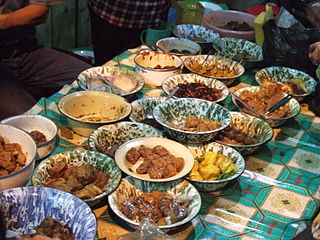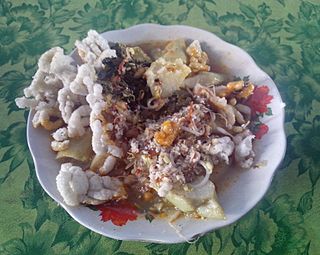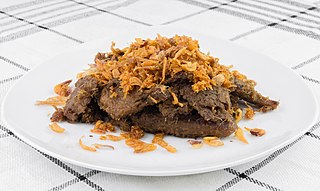
Tripe is a type of edible lining from the stomachs of various farm animals. Most tripe is from cattle, pigs and sheep.

Malay cuisine is the traditional food of the ethnic Malays of Southeast Asia, residing in modern-day Malaysia, Indonesia, Singapore, Brunei, Southern Thailand and the Philippines as well as Cocos Islands, Christmas Island, Sri Lanka and South Africa.

Rijsttafel, a Dutch word that literally translates to "rice table", is an Indonesian elaborate meal adapted by the Dutch following the hidang presentation of nasi padang from the Padang region of West Sumatra. It consists of many side dishes served in small portions, accompanied by rice prepared in several different ways. Popular side dishes include egg rolls, sambals, satay, fish, fruit, vegetables, pickles, and nuts. In most areas where it is served, such as the Netherlands, and other areas of strong Dutch influence, it is known under its Dutch name.

Clay pot cooking is a process of cooking food in a pot made of unglazed or glazed pottery.

Indomie is a brand of instant noodle produced by the Indonesian company Indofood. Indofood itself is the largest instant noodle producer in the world with 16 factories. Over 28 billion packets of Indomie are produced annually, and the brand is also exported to more than 90 countries around the world. Indomie has been produced mainly in Indonesia since it was first introduced in June 1972; it has also been produced in Nigeria since 1995. Indomie has become increasingly popular in Nigeria and other African countries since its introduction there in the 1980s.

Lontong is an Indonesian dish made of compressed rice cake in the form of a cylinder wrapped inside a banana leaf, commonly found in Indonesia, Malaysia, and Singapore. Rice is rolled inside a banana leaf and boiled, then cut into small cakes as a staple food replacement for steamed rice. The texture is similar to that of ketupat, with the difference being that the ketupat container is made from woven janur fronds, while lontong uses banana leaf instead.

Javanese cuisine is the cuisine of Javanese people, a major ethnic group in Indonesia, more precisely the province of Central Java, Yogyakarta and East Java.

Padang dish or Minangkabau dish is the cuisine of the Minangkabau people of West Sumatra, Indonesia. It is among the most popular cuisines in Maritime Southeast Asia. It is known across Indonesia as Masakan Padang after Padang, the capital city of Western Sumatra province. It is served in restaurants mostly owned by perantauan (migrating) Minangkabau people in Indonesian cities. Padang food is ubiquitous in Indonesian cities and is popular in neighboring Malaysia and Singapore.

Sundanese cuisine is the cuisine of the Sundanese people of Western Java, and Banten, Indonesia. It is one of the most popular foods in Indonesia. Sundanese food is characterised by its freshness; the famous lalab eaten with sambal and also karedok demonstrate the Sundanese fondness for fresh raw vegetables. Unlike the rich and spicy taste, infused with coconut milk and curry of Minangkabau cuisine, the Sundanese cuisine displays the simple and clear taste; ranged from savoury salty, fresh sourness, mild sweetness, to hot and spicy.

Nasi jamblang is a typical food of Cirebon, West Java. The "jamblang" term comes from the name of the region to the west of the city of Cirebon, where food vendors first sold the dish. A characteristic feature of the dish is the use of teak leaves to pack the rice. The dish is served buffet-style.

Docang or Doclang is a traditional food from Cirebon, a port town in West Java, Indonesia. It is made of sliced of rice cake, cassava leaves, sprouts, and krupuk, served in thick vegetable sauce called dage, which is made of mashed tempeh mixed with grated coconut. This food has a distinctive savoury flavor and usually served warm for breakfast and it is sold in relatively affordable price. Today, authentic docang is rarely found even in Cirebon.

Empal gepuk or sometimes simply known just as empal or gepuk is an Indonesian sweet and spicy fried beef dish. This dish is commonly popular in Java island, but can trace its origin to the Sundanese cuisine of West Java, Indonesia.

Betawi cuisine is rich, diverse and eclectic, in part because the Betawi people that create them were composed from numbers of regional immigrants that came from various places in the Indonesian archipelago, as well as Chinese, Indian, Arab, and European traders, visitors and immigrants that were attracted to the port city of Batavia since centuries ago.

Soto is a traditional Indonesian soup mainly composed of broth, meat, and vegetables. Many traditional soups are called soto, whereas foreign and Western influenced soups are called sop.

A stew is a combination of solid food ingredients that have been cooked in liquid and served in the resultant gravy. Ingredients can include any combination of vegetables and may include meat, especially tougher meats suitable for slow-cooking, such as beef, pork, venison, rabbit, lamb, poultry, sausages, and seafood. While water can be used as the stew-cooking liquid, stock is also common. A small amount of red wine or other alcohol is sometimes added for flavour. Seasonings and flavourings may also be added. Stews are typically cooked at a relatively low temperature, allowing flavours to mingle.

Indian Indonesian cuisine is characterized by the mixture of Indian cuisine with local Indonesian-style. This cuisine consists of adaptations of authentic dishes from India, as well as original creations inspired by the diverse food culture of Indonesia. Indian influence can be observed in Indonesia as early as the 4th century. Following the spread of Islam to Indonesia and trading, Muslim Indian as well as Arab influences made their way into Indonesian cuisine. Examples include Indian biryani, murtabak, curry and paratha that influenced Acehnese, Minangkabau, Malay, Palembangese, Betawi and Javanese cuisine.

Indonesian noodles are a significant aspect of Indonesian cuisine which is itself very diverse. Indonesian cuisine recognizes many types of noodles, with each region of the country often developing its own distinct recipes.

Trusmi Batik Village is a center of batik industry in Cirebon, West Java. The place is regarded as a tourist spot for batik art as well as local culinary. The village of Trusmi is located in the town of Plered, 4 km (2.5 mi) west of the city of Cirebon. There are over 1,000 batik craftsmen involved in the batik production in Trusmi, who are not only hailed from Trusmi but also from nearby areas, such as Gamel, Kaliwulu, Wotgali, and Kalitengah. In recent years, the Trusmi village has helped boost tourism to Cirebon.


















